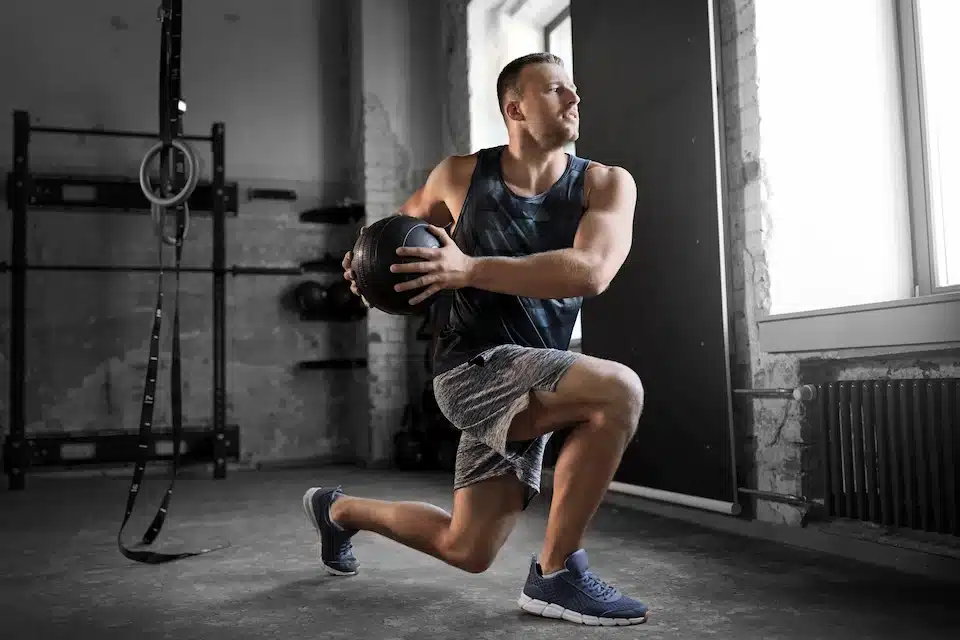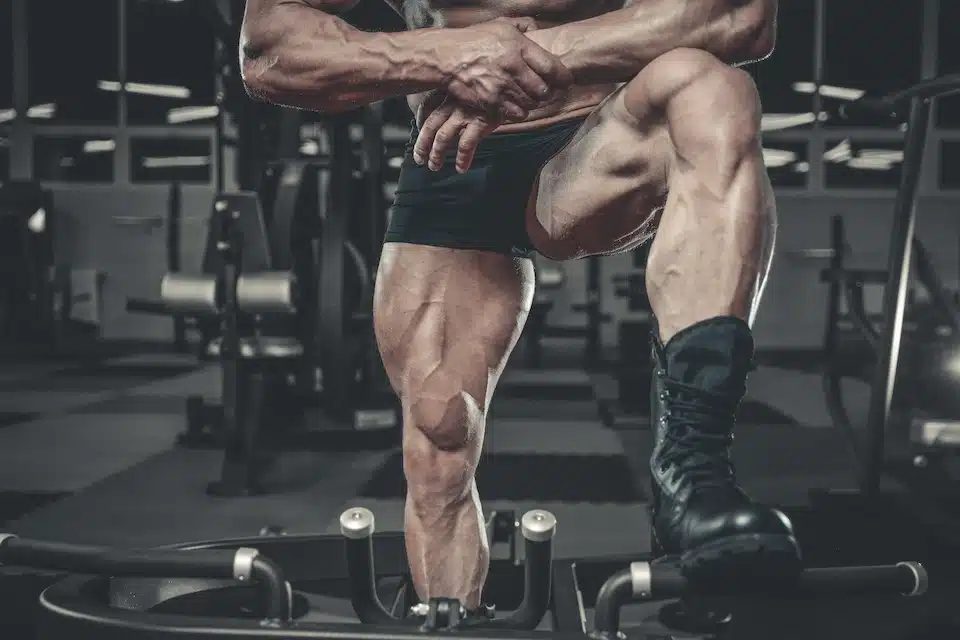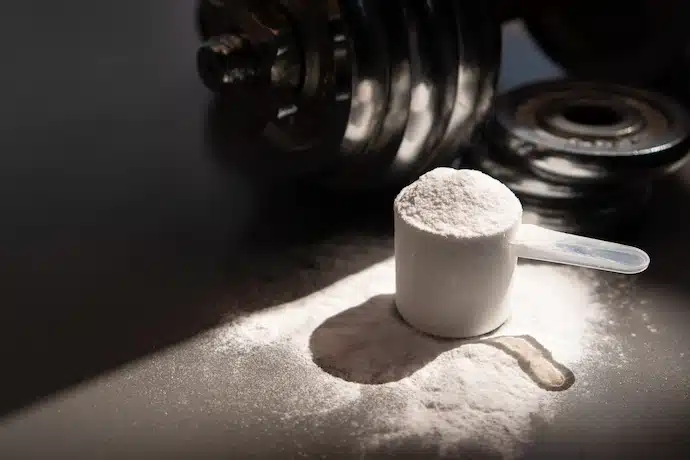Are you struggling to lose fat while trying to build muscle? What is body recomposition? It helps you burn fat and gain muscle at the same time. Transform your body today.
Key Takeaways
- Lose Fat and Gain Muscle
Body recomposition helps you burn fat and build muscle at the same time. This changes your body shape without just losing weight. - High-Protein Diet
Eating enough protein is key. Aim for 0.73 to 1 gram of protein per pound of your body weight each day to support muscle growth. - Calorie Cycling and Balanced Nutrition
Change your daily calories to keep your metabolism active. Balance proteins, carbs, and fats to lose fat while gaining muscle. - Effective Workouts
Use high-intensity interval training (HIIT) and strength training. These exercises help burn fat and build strong muscles. - Long-Term Health Benefits
Body recomposition improves your overall health, boosts your metabolism, and is a sustainable way to stay fit and strong.
Defining Body Recomposition
Body recomposition changes your body by reducing fat and increasing muscle. Unlike weight loss, which only drops pounds, it improves your muscle mass and overall physique.
Difference between body recomposition and simple weight loss
Body recomposition changes your physique by losing fat and gaining muscle. Simple weight loss cuts calories and does extra cardio. This approach often drops both fat and muscle mass.
Recomposition focuses on building muscle while shedding fat. Muscle growth boosts metabolism and improves strength. Weight loss might be slower or show no change on the scale because muscle is added as fat is lost.
Extreme calorie cuts or too much cardio can waste muscle. Recomposition requires a balanced diet and strength training to keep muscle mass while reducing body fat.
How Body Recomposition Works
Body recomposition relies on calorie cycling and balanced macronutrients – want to see how these tools can burn fat and build muscle? Keep reading!
The role of calorie cycling
Calorie cycling changes your daily calories to keep your metabolism active. On high-calorie days, you fuel workouts and support muscle growth. Low-calorie days create a deficit to burn fat.
This balance helps reduce body fat while building muscle.
Studies show eating 1.4 grams of protein per pound preserves muscle during fat loss. Mixing calorie intake with protein and strength training boosts body recomposition. Cycling calories prevents plateaus and keeps your body adapting.
Calorie cycling keeps your metabolism guessing and your muscles growing.
Balancing macronutrients
Balance your macros for better results. A high-protein diet helps burn fat and build muscle. Aim for at least 0.64 grams of protein per pound of body weight. To maximize muscle gain, consume between 0.73 to 1 gram per pound each day.
Use protein supplements like whey protein to reach your goals.
Include complex carbohydrates and healthy fats in your diet. Whole wheat foods and fruits provide energy for your workouts. Healthy fats support hormone production and overall health.
Tracking your macros ensures you get the right balance to achieve your fitness goals.
Key Strategies for Losing Fat and Building Muscle
Want to shred fat and build killer muscles? Explore these badass tactics—keep reading!
High-intensity interval training (HIIT)
High-intensity interval training (HIIT) burns fat and builds muscle. Push hard with sprints or burpees for 30 seconds. Rest for 10 seconds. Repeat for 20 minutes. HIIT boosts your metabolic rate and lowers body fat percentage.
Combine HIIT with resistance training like squats and deadlifts to maximize muscle growth.
HIIT is the no-BS way to shred fat and pack on muscle.
Consistency in cardio exercises
Keep your cardio on the regular to burn fat and build muscle. Regular cardiovascular workouts boost your calorie burn and keep your metabolism high. Pair steady cardio with weight lifting to preserve muscle while shedding fat.
Stick to a consistent cardio routine to support sustainable dieting and track your body composition progress.
Consistent cardio helps maintain your increased metabolism over time. It enhances calorie expenditure and supports sustainable dietary practices. By staying on top of your cardio exercises, you ensure effective body recomposition and monitor your progress effectively.
Strategic caloric deficits
Once you crush your cardio routine, it’s time to dial in your diet. Cycle your calories to torch body fat while keeping your workout energy high. Don’t starve yourself—maintain a slight calorie deficit for steady results.
Strategic caloric deficits might slow fat loss, but they boost muscle growth and drop your body fat percentage. Stick to a balanced diet with whole, nutrient-dense foods to support your recomposition.
This method increases lean body mass and reduces body fat effectively.
How to Burn Belly Fat While Building Muscle
Burn belly fat and build muscle like a beast. Crush your goals with these killer strategies.
- Boost Your Fiber Intake
Eat more veggies and beans. Fiber keeps you full and burns fat around your belly. Try adding spinach, broccoli, and lentils to your meals. - Cut Down on Sugary Carbs
Ditch the candy and sugary snacks. Replace them with protein-rich foods and healthy fats. Opt for whole-wheat bread and oatmeal instead of white bread. - Limit Processed Foods
Stay away from junk food. Processed foods add extra body fat. Choose whole, unprocessed foods like eggs and lean meats. - Lift Heavy Weights
Hit the weight room hard. Lifting weights builds muscle and boosts your metabolism. Focus on bench presses, bent-over barbell rows, and free weights. - Increase Protein Intake
Load up on protein powder and high-protein foods. Protein helps build muscle and burns fat. Aim for at least the recommended daily allowance. - Do High-Intensity Interval Training (HIIT)
Smash your cardio with HIIT workouts. These burn fat fast and keep your muscles growing. Try sprint intervals or jump rope sessions. - Maintain a Caloric Deficit
Eat fewer calories than you burn. This forces your body to use fat for energy. Use a tracking app to monitor your caloric intake. - Stay Consistent with Cardio
Keep up regular cardio exercises. Consistent cardio helps you lose weight and improves heart health. Mix in steady-state cardio with your HIIT sessions. - Prioritize Recovery
Give your muscles time to grow. Proper rest prevents injury and boosts muscle growth. Ensure you get enough sleep and take rest days. - Choose Nutrient-Dense Foods
Fuel your body with the right nutrients. Foods like eggs, beans, and whole-wheat products provide essential vitamins. Avoid empty-calorie foods that offer no benefits.
Follow these steps to torch belly fat and build solid muscle. Stay dedicated and watch your body transform.
Effective Methods for Gaining Muscle
Ready to grow those guns? Pump iron and load up on protein to build serious muscle.
Importance of protein intake
Protein fuels your muscle gains. Hit 0.73 to 1 gram per pound daily. Bodybuilders and weightlifters rely on this for muscle-building. A study of 49 research pieces found that adding a 35-gram protein shake helps those eating 0.64 grams per pound.
Protein supports muscle hypertrophy and speeds up recovery after weight training.
No pain, no gain, but no protein either.
Balance your macros to maximize muscle growth. Focus on high-quality sources like lean meats, eggs, and legumes. Don’t skip your protein to build higher muscle mass and crush your fitness goals.
Weight training essentials
Strength training builds muscle and burns fat. Use resistance exercises like weightlifting. Experts advise lifting weights at least two days each week. Focus on exercises such as squats, bench presses, and deadlifts.
These target key muscle groups for growth.
Increase the weight as you get stronger. Use proper form to stay safe. Mix sets and repetitions to challenge muscles. Combine weight training with high protein foods for best gains.
Include rest days to let muscles recover and grow.
Recovery and muscle growth
Adequate recovery boosts muscle growth. Sleep well and rest your muscles between workouts. Increased muscle mass raises your resting metabolic rate, burning more calories each day.
Eat enough protein to support muscle repair and growth. A high-protein diet combined with weight-training builds fat-free mass. Use calorie cycling to match your intake with your goals.
This balanced approach helps you lose fat and gain muscle effectively.
Benefits of Body Recomposition
Body recomposition builds muscle, burns fat, and boosts your health—keep reading to smash your fitness goals.
Improved overall health and fitness
Losing fat cuts your risk of diabetes, cancer, and heart disease. Building muscle raises your metabolism by 20%, so you burn more calories all day. Better insulin sensitivity and a healthy BMI fight obesity and other health threats.
Recomposition boosts your overall health and helps prevent chronic illnesses. Now, let’s explore how it enhances metabolic efficiency.
Enhanced metabolic efficiency
Building muscle cranks up your resting metabolic rate (RMR). Even when you’re chilling, you burn more calories. More muscle means you trash fat tissue faster. A boosted metabolism keeps you shredded and fights off health problems.
Enhanced metabolic efficiency lets you lose fat and build muscle at the same time.
Long-term sustainability
Long-term sustainability is the heart of body recomposition. This approach isn’t a fleeting fad diet—it’s a permanent lifestyle shift. By balancing how you burn fat and build muscle, you improve your body mass index (BMI) and boost overall health benefits.
Unlike low-calorie diets that leave you hungry and weak, body recomposition promotes steady muscle growth and fat loss. Consistent workouts and smart nutrition ensure you maintain your gains without the yo-yoing of traditional weight-loss programs.
Embrace this method to achieve lasting fitness and strength.
Body Recomposition Diet Tips
Load up on protein-rich foods to shred fat and build muscle. Time your meals right and add supplements like leucine to power your body recomposition journey.
Nutrient-dense foods for optimal results
Add lean protein to every meal—aim for 20 grams. Choose chicken, fish, or tofu. Include healthy fats from nuts, seeds, or olive oil. Fill up with fibrous veggies like spinach, broccoli, and berries.
These nutrient-dense foods support muscle growth and fat loss.
Meal timing and frequency
Eating the right food at the right time fuels your workouts. Before exercising, have a meal with twice as many carbs as protein. This gives you energy and keeps you full. After your workout, eat another 2:1 carb-protein meal.
This helps build muscle and burn fat.
Space your meals every 3–4 hours. Frequent eating keeps your metabolism active. It supports low calorie diets by enhancing satiety. This timing boosts body recomposition results.
Recommended supplements
Use protein supplements to reach 0.73 grams per pound. Whey protein is a top choice for quick absorption. It helps build muscle and supports recovery. Add branched chain amino acids (BCAAs) to your routine.
Take 5 grams before or after workouts. BCAAs reduce muscle soreness and boost growth. These supplements enhance your bodybuilding efforts and improve physical capabilities.
Conclusion
Body recomposition transforms your body by losing fat and gaining muscle. This boosts your metabolism and makes you stronger. Follow a solid plan with the right diet and workouts to see real changes.
Stay consistent and watch your fitness improve. Start today and build a healthier, fitter you.
FAQs
1. What is body recomposition?
Body recomposition is the process of changing your body by burning fat and building muscle at the same time. It focuses on improving your body mass index (BMI) and overall fitness without just losing weight.
2. How can I burn fat and build muscle effectively?
To burn fat and build muscle, combine strength training with cardiovascular exercise. High intensity interval training (HIIT) and cardio workouts like running or cycling help burn calories per gram, while weight lifting builds muscle. Good sports nutrition also supports these goals.
3. What types of exercise are best for body recomposition?
A mix of aerobic exercises and high intensity interval training (HIIT) is ideal. Cardio workouts like swimming, biking, or using the elliptical machine help burn fat. Strength training exercises, such as lifting weights, help build muscle and improve your BMI.
4. How does diet affect body recomposition?
Eating the right foods is key. Focus on sports nutrition by consuming enough protein to build muscle and managing calorie intake to burn fat. Foods like oat-bran can help dieters stay full and support weight loss programs. Monitoring calories per gram ensures you get the nutrients needed without overeating.
5. What are the benefits of body recomposition?
Body recomposition improves your BMI and reduces the risk of health issues like heart problems. It helps you become stronger and more fit by building muscle and burning fat. Additionally, it enhances your overall appearance and boosts confidence, making it a beneficial goal for those who are overweight or looking to improve their health.







